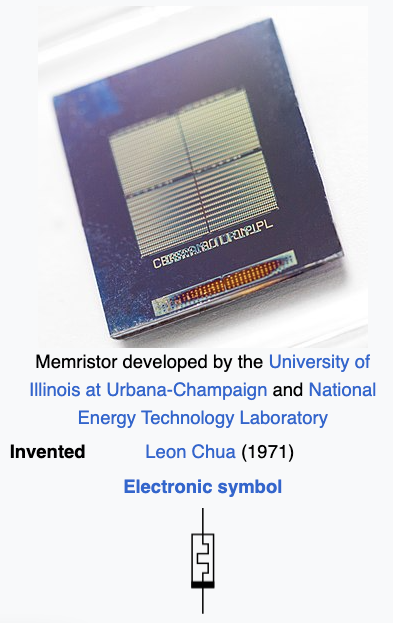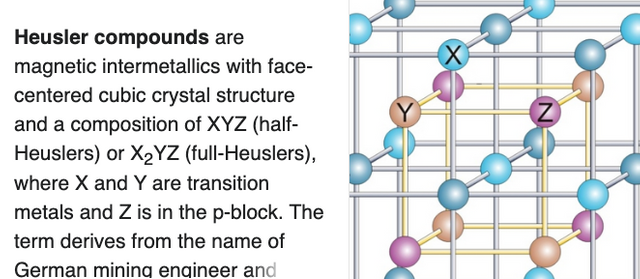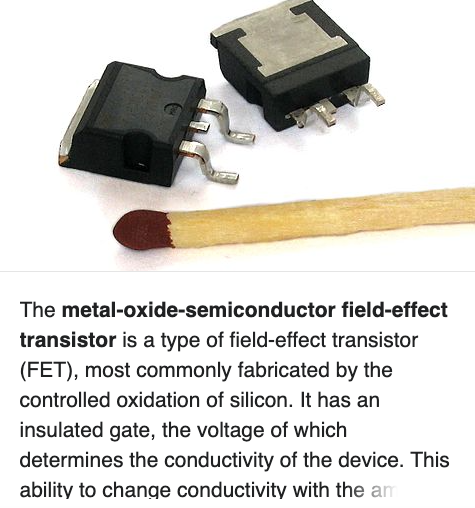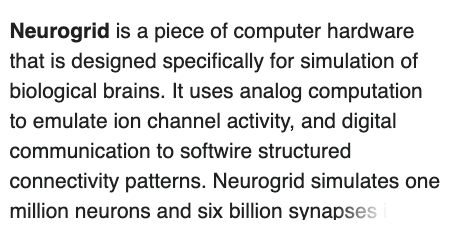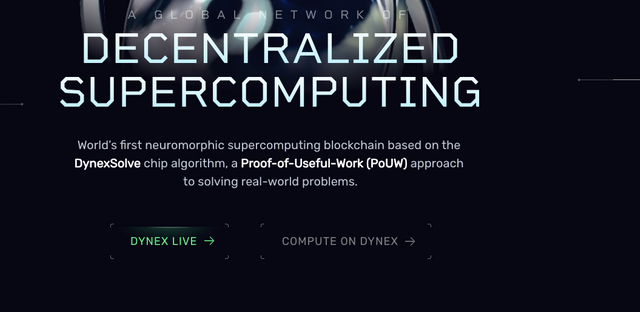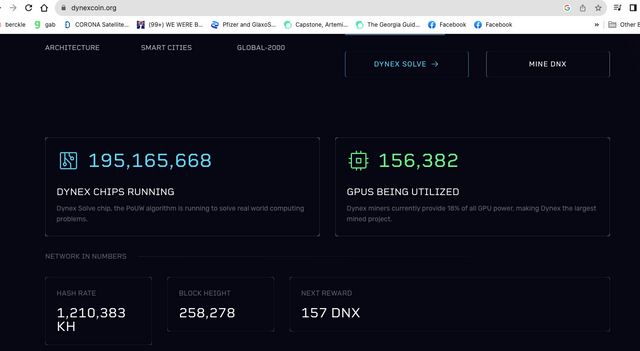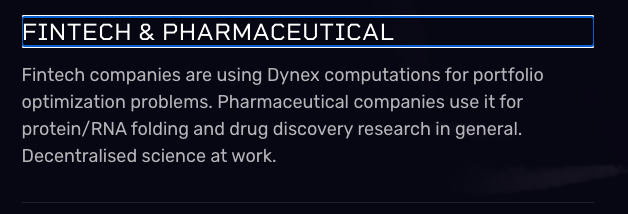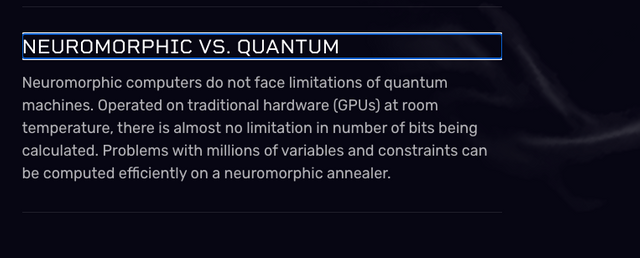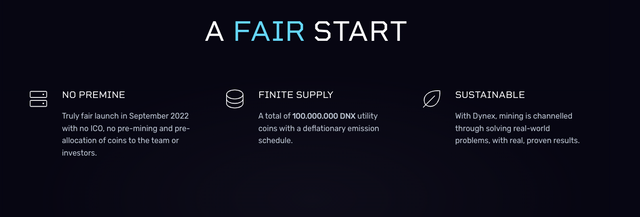What is Neuromorphic Computing? Has Moore's Law Come to an END?
Is it true that~ transistors cannot be made much smaller any more, CPU speed is not doubling every two years any more?
Do you find that interesting as ALL including humanity is energy?
Do many still see Quantum Computing as experimental and still in it's early stages?
Yet, many have thrown money on it and there is a great deal to consider Behind it.
For example~
HOLD ON JUST A LITTLE BIT LONGER! THE KINGDOM IS HERE PART 1
https://www.bitchute.com/video/mcuYV3IloFZ9/
https://steemit.com/greatawakening/@artistiquejewels/expand-your-thinking
So as more data is still being produced on an exponential level Every Day,
with no machines to solve really complex mathematical problems,
how can one deal with this?
Some believe neuromorphic computing is the answer!
Is it? You decide!
According to an Abstract from Nature,
Guided by brain-like ‘spiking’ computational frameworks, neuromorphic computing—brain-inspired computing for machine intelligence—promises to realize artificial intelligence while reducing the energy requirements of computing platforms. This interdisciplinary field began with the implementation of silicon circuits for biological neural routines, but has evolved to encompass the hardware implementation of algorithms with spike-based encoding and event-driven representations. Here we provide an overview of the developments in neuromorphic computing for both algorithms and hardware and highlight the fundamentals of learning and hardware frameworks. We discuss the main challenges and the future prospects of neuromorphic computing, with emphasis on algorithm–hardware codesign.
https://www.nature.com/articles/s41586-019-1677-2
- A neuromorphic computer/chip is any device that uses physical artificial neurons to do computations.
- neuromorphic has been used to describe analog, digital, mixed-mode analog/digital VLSI, and software systems that implement models of neural systems [for perception, motor control, or multisensory integration].
- The implementation of neuromorphic computing on the hardware level can be realized by oxide-based memristors, spintronic memories, threshold switches, transistors.
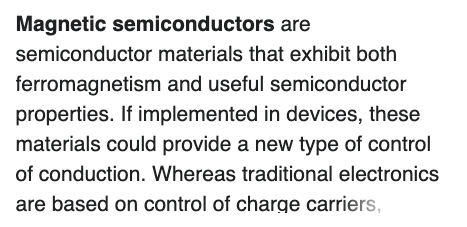
memristor
a non-linear two-terminal electrical component relating electric charge and magnetic flux linkage.
named in 1971 by Leon Chua, completing a theoretical quartet of fundamental electrical components which also comprises the resistor, capacitor and inductor.
Several such memristor system technologies have been developed, notably ReRAM.
[Resistive random-access memory (ReRAM or RRAM) is a type of non-volatile (NV) random-access (RAM) computer memory that works by changing the resistance across a dielectric solid-state material, often referred to as a memristor.]
ReRAM bears some similarities to conductive-bridging RAM (CBRAM) and phase-change memory (PCM). CBRAM involves one electrode providing ions that dissolve readily in an electrolyte material, while PCM involves generating sufficient Joule heating to effect amorphous-to-crystalline or crystalline-to-amorphous phase changes.
By contrast, ReRAM involves generating defects in a thin oxide layer, known as oxygen vacancies (oxide bond locations where the oxygen has been removed), which can subsequently charge and drift under an electric field. The motion of oxygen ions and vacancies in the oxide would be analogous to the motion of electrons and holes in a semiconductor.
RRAM is the registered trademark name of Sharp Corporation, a Japanese electronic components manufacturer, in some countries, including members of the European Union.
An energy-efficient chip called NeuRRAM fixes an old design flaw to run large-scale AI algorithms on smaller devices, reaching the same accuracy as wasteful digital computers, at least for applications needing only a few million bits of neural state. As NeuRRAM is an analog technology, it suffers from the same analog noise problems that plague other analog semiconductors. While this is a handicap, many neural processors do need bit-perfect state storage to do useful work.
spintronics
aka spin electronics,
- the study of the intrinsic spin of the electron and its associated magnetic moment, in addition to its fundamental electronic charge, in solid-state devices.
- field of spintronics concerns spin-charge coupling in metallic systems; the analogous effects in insulators fall into the field of multiferroics.
materials that exhibit more than one of the primary ferroic properties in the same phase:
ferromagnetism – a magnetisation that is switchable by an applied magnetic field
ferroelectricity – an electric polarisation that is switchable by an applied electric field
ferroelasticity – a deformation that is switchable by an applied stress
- Spintronics fundamentally differs from traditional electronics in that, in addition to charge state, electron spins are used as a further degree of freedom, with implications in the efficiency of data storage and transfer. Spintronic systems are most often realised in dilute magnetic semiconductors (DMS) and Heusler alloys and are of particular interest in the field of quantum computing and neuromorphic computing.
Neuromorphic engineering is an interdisciplinary subject that takes inspiration from
biology,
physics,
mathematics,
computer science,
electronic engineering
to design artificial neural systems, such as
vision systems,
head-eye systems,
auditory processors,
autonomous robots,
whose physical architecture and design principles are based on those of biological nervous systems.
Neuromorphic engineering is for now set apart by the inspiration it takes from what we know about the structure and operations of the brain. Neuromorphic engineering translates what we know about the brain's function into computer systems. Work has mostly focused on replicating the analog nature of biological computation and the role of neurons in cognition.
The biological processes of neurons and their synapses are dauntingly complex, and thus very difficult to artificially simulate. A key feature of biological brains is that all of the processing in neurons uses analog chemical signals. This makes it hard to replicate brains in computers because the current generation of computers is completely digital. However, the characteristics of these parts can be abstracted into mathematical functions that closely capture the essence of the neuron's operations.
The goal of neuromorphic computing is not to perfectly mimic the brain and all of its functions, but instead to extract what is known of its structure and operations to be used in a practical computing system.
computation is highly distributed throughout a series of small computing elements analogous to a neuron. While this sentiment is standard, researchers chase this goal with different methods.
As early as 2006, researchers at Georgia Tech published a field programmable neural array.
This chip was the first in a line of increasingly complex arrays of floating gate transistors that allowed programmability of charge on the gates of MOSFETs to model the channel-ion characteristics of neurons in the brain and was one of the first cases of a silicon programmable array of neurons.
most commonly fabricated by the controlled oxidation of silicon. It has an insulated gate, the voltage of which determines the conductivity of the device. This ability to change conductivity with the amount of applied voltage can be used for amplifying or switching electronic signals.
In November 2011, a group of MIT researchers created a computer chip that mimics the analog, ion-based communication in a synapse between two neurons using 400 transistors and standard CMOS manufacturing techniques.
complementary metal-oxide semiconductor
In June 2012, spintronic researchers at Purdue University presented a paper on the design of a neuromorphic chip using lateral spin valves and memristors. They argue that the architecture works similarly to neurons and can therefore be used to test methods of reproducing the brain's processing. In addition, these chips are significantly more energy-efficient than conventional ones.
Purdue e-pubs
https://docs.lib.purdue.edu/dissertations/AAI3506202/
https://dl.acm.org/doi/abs/10.1145/2228360.2228594
https://ieeexplore.ieee.org/abstract/document/6257039
Neurogrid, built by Brains in Silicon at Stanford University, is an example of hardware designed using neuromorphic engineering principles. The circuit board is composed of 16 custom-designed chips, referred to as NeuroCores. Each NeuroCore's analog circuitry is designed to emulate neural elements for 65536 neurons, maximizing energy efficiency. The emulated neurons are connected using digital circuitry designed to maximize spiking throughput.
From Bitcourier concerning Dynex,
Our mission is to connect as many people together to form the world’s first decentralised neuromorphic supercomputing platform. This means, every single computation of every mining step will be turned into neuromorphic computations. These are being used to run tasks in the network. For example, a university can use the combined power to solve a complex formulation to develop a new medicine. Or a corporation needs to calculate solutions to an optimisation problem to optimise their supply chain or logistics. The applications are practically only limited by our imagination.
The founder and lead architect of the Dynex project, Sumitomo states,
Our mission is to connect as many people together to form the world’s first decentralised neuromorphic supercomputing platform. This means, every single computation of every mining step will be turned into neuromorphic computations. These are being used to run tasks in the network. For example, a university can use the combined power to solve a complex formulation to develop a new medicine. Or a corporation needs to calculate solutions to an optimisation problem to optimise their supply chain or logistics. The applications are practically only limited by our imagination.
Interviewer Chris asks,
How are you able to perform computations at unprecedented speed and efficiency?
Sumitomo: Over the last two years we have created a proprietary neuromorphic chip design. To simply explain what it does:
On today’s traditional computers, we have CPU and memory separated, and they have to communicate with each other.
This leads to a bottleneck (the “Van-Neumann bottleneck”) - one than can only really be overcome through significant changes to computer or processor architectures.
And this is exactly what our chip design does:
- it performs computation in a combined, parallel way (“memcomputing”).
- This allows the chip to compute thousands and millions of operations in parallel, making it orders of magnitude faster than traditional computers.
- What’s interesting is, that we can simulate these chips on regular hardware efficiently.
- This is done by solving “equations of motion”, similar to, for example what NASA does when they are simulating the movement of a meteor traveling through space.
The striking thing is, it turns out that
even the simulation alone shows almost all of the benefits of such a neuromorphic chip!
We have been able to solve constraint satisfaction problems with this technology faster than any other technology currently available.
In fact, traditional systems would never even finish finding the solution as it would take them longer than the universe exists.
Our Dynex chips found a solution within a few seconds.
Sumitomo: The Dynex coin “DNX” is the utility coin used to get paid for computing power provided. Customers, who want to use the network to perform calculations, need to pay in DNX. We have multiple wallets, the easiest probably the Dynex Mobile Web Wallet. There’s no installation or download required, everyone can open a Dynex wallet in just a few clicks. Dynex wallets are being used to store, send and receive DNX. It also offers the functionality to transfer DNX between two users by simply scanning a QR-Code.
Chris: Is there a story behind the creation of the project? Can you share it please?
Sumitomo: I guess behind every great project is always a story :)
We actually never intended to build a blockchain or to launch a coin.
Our main research interest was to create the Dynex chip, a neuromorphic chip to solve the issue of Moore’s law ending.
We tried so many different approaches, looked everywhere to see what research in this area is out there currently.
Slowly we narrowed down the most feasible approaches to neuromorphic computing.
Our first chip design could solve problems with up to eight variables and was implemented on breadboards with a number of Raspberry Pis connected.
It was huge and very unpractical, but it did what it was supposed to do: Perform memprocessing and thus doing things for real in parallel.
Building instantons and long-range order, similar to what we usually see in quantum machines.
In quantum field theory, an instanton is a topologically nontrivial field configuration in four-dimensional Euclidean space (considered as the Wick rotation of Minkowski spacetime). Specifically, it refers to a Yang–Mills gauge field A which approaches pure gauge at spatial infinity.
With this being a great motivator for us, we implemented the chip’s functionality on FPGAs and put together around 1,500 FPGAs to form a cluster of our Dynex chips.
The tests confirmed the functionality, but we soon realised that we cannot scale this cluster ourselves so easily.
The market for FPGAs was very dried out at that moment, so we had to think out of the box.
FPGA's are Field Programmable Gate Arrays are semiconductor devices that are based around a matrix of configurable logic blocks (CLBs) connected via programmable interconnects.
Out of the Box Thinking
That was the time when an article caught our attention, addressing the issue of energy used for crypto-mining.
We realised that a lot of computing power is being wasted every single minute on just calculating hashes. Why not utilise this energy to do something meaningful?
That’s when we decided that we have to a decentralised approach. Together with a blockchain and a coin. Dynex was born…
Chris: What are your main goals in the next 3-6 months?
Sumitomo: We launched the Dynex main-net on September 16th, 2022 with the possibility to have the miners choose how they want to contribute: by traditional mining or by running Dynex chips (or a combination). Even without any advertising, quickly a community emerged and a lot of people joined.
Just four weeks after launch we already had four mining pools, a first listing on txbit.io and a community of hundreds of people supporting us. Dynex chip operations ramped up rapidly to almost 5,000,000,000 computing steps, we know now that the Dynex chip can operate also on large scale very successfully.
As a next step, we will merge the chip’s functionality directly into our mining algorithm (“DynexSolve”). This will be rolled out after successful testing (which started on November 1st, 2022).
In parallel we are currently selecting large formulations and computations which will be run on our network, leading to building up a customer base for usage of computation power as well. We are also considering listing on an additional exchange.
In short: plenty of work for the next few months, but creating a meaningful project with impact on our world is absolutely worth it.
Please join our Discord channel as well as our Twitter account, that’s the two places where we share all updates.
To hear from someone who mines go here as he has a 3070 GPU rig and a 6600 rig [used in gaming for years, GPUs can process many pieces of data simultaneously],
Is DYNEX going to BRING back GPU Mining?
With Dynex, PoUW miners participate on a decentralized network that is capable of performing tasks at unprecedented speed and efficiency – even exceeding quantum computing in some cases.
This is made possible with a proprietary neuro-morphic super chip algorithm called **DynexSolve, **that utilizes the GPU & computing network to solve real world problems with endless use cases.
As a community and with collaborative effort we can take the next step towards sustainability and efficiency.
Transform your computer or your dormant GPU mining equipment into neuromorphic machines, earn benefits and generate wealth: let’s solve problems together.
As of 9.2.2023
Machine learning and optimizations,
Quantum computing algorithms for machine learning harness the power of quantum mechanics to enhance various aspects of machine learning tasks.
As both, quantum computing and neuromorphic computing are sharing similar features, these algorithms can also be computed efficiently on the Dynex platform directly within Python – but without the limitations of quantum machines.
The major mile-stone for Dynex was the launch of DynexSolve, our proprietary Proof-of-Useful-Work mining algorithm on 12.1.2022
Dynex's utility coin $DNX listed on BitMart on June 5th, 2023 as another mile-stone to allow a larger audience to trade DNX.
Secure a 5%+ market share of all GPUs to mine DNX, thus providing PoUW computing power to the Dynex Platform.
We will celebrate the festive season with a very special surprise...
Dynex will generate revenue by providing neuromorphic computing to its customers.
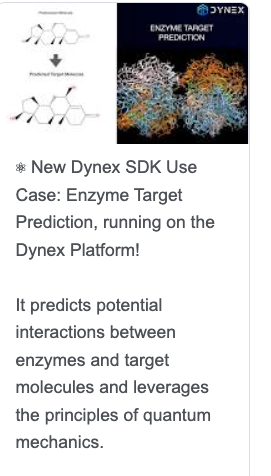
https://twitter.com/dynexcoin/status/1697669276767830025?ref_src=twsrc%5Egoogle%7Ctwcamp%5Eserp%7Ctwgr%5Etweet
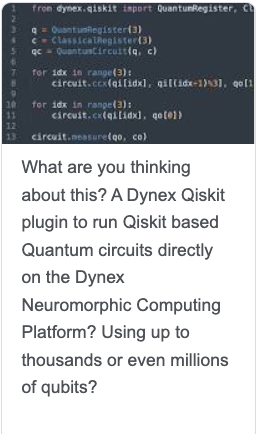
I have to take off for a moment.
Coming back in with more info!
#NeuromorphicComputing, #Dynex, #DNX, #Purdue, #MooresLaw, #QuantumComputing, #NeuromorphicEngineering, #quantum
More Sources,
https://ieeexplore.ieee.org/abstract/document/6257039

